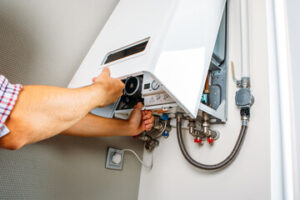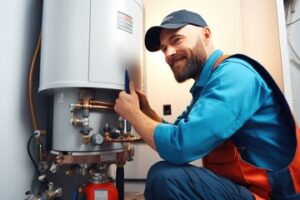Plumbing systems remove waste, provide hot and cold water, and regulate indoor climate. Plumber Tampa installs, maintains, and repairs these systems. They often use specialized tools and follow blueprints to place and connect pipes and fixtures properly.

The job can be physically demanding and requires on-call hours for emergencies. However, it is an excellent career choice for people who like to work with their hands and meet new people daily.
Installing plumbing systems: This includes laying pipe, connecting fixtures and appliances, such as sinks and toilets, installing water heaters and more. This job requires attention to detail, as well as following building codes and blueprints. Plumbers also perform routine maintenance on plumbing systems, such as unclogging drains and repairing leaks. They use specialized tools to inspect pipes and drains for damage and make repairs as needed.
Service and repair: Plumbers are called in when a household or business has a problem with its plumbing. This can include clogged or blocked drains, malfunctioning water heaters, and more. These plumbers troubleshoot the issue and fix it as needed, often using specialized equipment like augers or snakes. They may also be responsible for installing or repairing backflow prevention devices. Plumbers in this role must have strong customer service skills and be able to explain complicated plumbing issues in an easy-to-understand way.
Construction: Plumbers who work on new construction projects install the plumbing systems for these structures, including piping, appliances and fixtures. This job involves working closely with builders and architects to ensure that the plumbing meets all necessary specifications. Construction plumbers also handle the plumbing for large-scale construction projects, such as hospitals and factories.
Continuing education and training: Plumbers must continue their education to stay relevant in the field. This is especially important as plumbing technology changes and new regulations are implemented. In addition, many plumbers participate in apprenticeship programs, where they learn the trade while earning a wage.
Physical demands: Plumbers must be able to lift heavy objects and work in tight spaces. They also need good eye-hand coordination to operate power tools and other machinery. Plumbers must be healthy enough to climb stairs and ladders when necessary and work outdoors in inclement weather.
Because of the nature of their work, plumbers are at risk for exposure to hazardous materials, such as asbestos, lead, chemicals and other harmful bacteria and viruses. This is because plumbers are frequently required to enter crawlspaces and other confined spaces that can be difficult to clean. In some cases, plumbers must also wear protective gear when completing a job.
Education and Training Requirements
Plumbing is a trade that requires extensive training to become proficient in the field. Plumbers are trained either through a formal apprenticeship or a vocational school program that includes classroom instruction and on-the-job experience. College-level plumbing programs can also provide the necessary knowledge and skills for working in this career.
The majority of plumbing education and training takes place through a formal union or trade organization apprenticeship. This type of program lasts four to five years and provides a combination of classroom instruction and paid on-the-job training. Apprenticeship programs require a high school diploma or equivalent and typically include OSHA safety training, blueprint reading instruction, and in-depth training on local plumbing codes and regulations.
In addition to these core skills, plumbers must be able to think critically and solve problems in an effective manner. They must be able to weigh various solutions and choose the most cost-effective course of action. Additionally, they must be able to communicate clearly with customers and explain the work required and associated costs.
Plumbers may work in a variety of environments, including residential, commercial, and industrial settings. As they gain more experience, plumbers will be entrusted with more complex tasks and projects. This includes performing plumbing inspections, repairing sewage systems, and designing plumbing systems.
While most plumbers are employed by businesses and organizations, some pursue freelance opportunities. This option can offer more flexibility in scheduling and choice of clients, but it does come with a greater degree of risk. Freelance plumbers must have sufficient financial resources to cover all their expenses while working on projects.
Because plumbers are often exposed to dangerous chemicals and sewage, they must be able to follow strict safety protocols. In addition, they may be required to enter small spaces and crawl through tight areas, which can cause discomfort or even injury. As a result, plumbers must be physically strong and prepared for demanding work conditions.
Licensing Requirements
A career as a plumber can be rewarding for individuals who enjoy working with their hands and solving problems. There are a variety of routes to becoming a plumber, including attending a trade school program or undertaking a formal apprenticeship. Apprenticeship programs typically last four years and combine classroom instruction with paid on-the-job training. Some apprenticeships also include training in specialized areas of plumbing, such as pipe fitting or backflow prevention device testing.
After completing an apprenticeship, prospective plumbers must obtain a license to work in their chosen field. Requirements vary by state and locality. A license is normally required to perform plumbing tasks that carry a significant amount of risk or those that involve the installation of gas lines. Plumbers must be knowledgeable about building codes and regulations. They interpret blueprints and plans to ensure that plumbing projects are constructed according to local and federal laws. Plumbers also inspect, maintain, and repair plumbing systems.
Those who wish to become a licensed journeyman plumber must complete a training program that includes 2,000 hours of on-the-job experience. Applicants must also take and pass a state-approved exam. Some jurisdictions also require a high school diploma.
The licensing requirements for a journey plumber in Rhode Island are similar to those of a licensed master plumber. In both cases, a high school diploma is required to start the apprenticeship. The duration of the program is four to five years and includes 2,000 hours of on-the-job training in addition to classroom instruction. Journey plumbers must be proficient in installing, repairing and maintaining a wide range of plumbing fixtures.
Work Environment
As a plumber, your job can be very demanding. But it also offers a great deal of variety, depending on the nature of the work you do and the environment in which you carry it out. For example, domestic plumbers will often be required to do a lot of work in people’s homes and apartments, which can be quite challenging as they may have to work in tight spaces and around lots of furniture, fixtures, and appliances.
Another type of plumbing work involves working on large-scale projects for public buildings like schools, hospitals, and shopping centres. These are very different environments to residential settings and require a lot of planning, organising, and coordination as well as the ability to work under pressure. Plumbers who work on these kinds of larger-scale projects are typically employed by companies that specialise in the construction of such facilities or by local water supply companies.
Plumbers are sometimes called out to attend emergency call-outs as well, and this is a very varied and unpredictable part of the job. For example, you could spend all day in one home fitting out an entire new plumbing system and then be sent out to a job at night to repair a burst pipe that has caused flooding or a gas leak. The variety of the work means that you can never be sure what to expect from one day to the next, which is good news for anyone who wants a career that provides plenty of opportunities for variety and interest.
Plumbers are often required to do a lot of heavy lifting and bending, as they might have to work in awkward positions under sinks or behind walls. They also spend a lot of time standing and moving about during their jobs, so it’s important that they have a good level of physical stamina. The variety of the work, together with the potential for significant financial rewards, can make being a plumber an appealing option for many people. But it’s important to remember that the industry is demanding and requires a high level of skill, so you should only consider it after thorough research into what’s involved in terms of both the training and the work itself.


